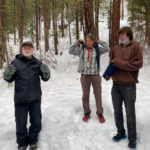
CWSC staff lead a discussion on forest health with students at Cascade High School
CWSC Director Barbara Carrillo and Steering Committee member Lloyd McGee enjoyed the opportunity of working with the Natural Resource students at Cascade High School recently to enhance their understanding of forest health. The students, led by teacher Eric Bard and CWSC staff, participated in a forest health assessment of their small forest plot of land located on the northeast corner of Rattlesnake Hill behind the high school to determine the health of the forest and how it should be managed for health and fire. CWSC and the class climbed the hill and learned about the health of the forest in a thicker and unmaintained area and checked for various conditions on the forest such as density and spacing of trees, fuels loads on the forest floor and tree circumference. Tree health was addressed and students learned about diseases such as Mistletoe, root rot, red needles causing infection and beetle infestation and learned that a healthy tree will “pitch” out bark beetle to prevent infestation. The students also learned about bark beetle traps and pheromone traps. The application of traps and pheromones can be used as an integrative pest management tool in creating forest health. CWSC staff also led the students to a healthy section of the small forest where the elements of a healthy forest were reviewed. The students learned to compare the spacing of trees in a “managed” section where trees were spaced appropriately approximately six feet apart, limbed up and exposed to direct sunlight to grow. The positive impact of native trees were discussed such as the native Ponderosa Pine and their natural resistance to fire and drought on the eastern slopes of the Cascades under healthy conditions. Climate change was also discussed and its impact and creation of drier forests worldwide. The students also learned about methods of restoration and fuel reduction such as mechanical thinning, limbing up, prescribed burning, fuel breaks, clearing with hand tools and commercial thinning was also reviewed.
The day ended in the classroom discussing careers in forest health such as a fire ecologist, silviculturist, soil scientist, forest logging manager, forester, forest engineer, conservation officer, community planner, forest engineer, forestry consultant, wildland firefighter and conservation scientist or rangeland manager.
The CWSC will be assisting Mr. Bard and his class in the spring with plantings and additional learning segments on forest health. If you would like to volunteer for upcoming education days in the forest, please contact the CWSC at [email protected].
